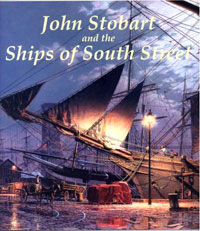 Last year the National Maritime Historical Society (NMHS) published a fascinating booklet, John Stobart and the Ships of South Street, which features the pre-eminent maritime artist’s paintings of ships arriving or departing from New York’s South Street docks.
Last year the National Maritime Historical Society (NMHS) published a fascinating booklet, John Stobart and the Ships of South Street, which features the pre-eminent maritime artist’s paintings of ships arriving or departing from New York’s South Street docks.
At first the presentation struck me as odd. The NMHS describes it as a booklet rather than a book, which is apt, as it is soft cover and only twenty four pages. John Stobart’s work is best enjoyed at full size. The prints of his paintings are breathtaking and worthy of study for their technical accuracy as well as his skillful composition and his breathtaking use of light and shadow. Can such a slight volume do Stobart’s work justice? After a few minutes of study, it became clear to me, that it can and indeed does.
While a larger format would be wonderful, the truth is that Stobart’s work is fascination at at almost any size. At only $10, the booklet is an excellent introduction to Stobart and the ships of South Street. Following an introduction by Peter Stanford, President Emeritus of the NMHS, the booklet begins with an essay by Stobart describing his early career and how he found his way to the then fledgling South Street Seaport. He writes:
The small office Peter [Stanford] headed at 203 Front Street had become the gravitation point for all those, young and old, who had a passion to see South Street live again as a vibrant new center of the city’s maritime heritage. That office was a fabulous source of reference material for me. At every turn fascinating people were appearing at the top of the staircase. These would include Alan Villiers, who sailed the Joseph Conrad around the world with a crew of young trainee sailors in the 1930s; Archie Horka, who shipped out in the bark Callao on a Cape Horn passage to Chile from South Street in 1924; Fred Harvey, who had sailed in whaleships and served as boatswain in the famous downeaster Shenandoah on her final trip to New York in 1910. And there were others, led by Karl Kortum, head of the San Francisco Maritime Museum, who sailed in the last Cape Horn voyage of the downeaster Kaiulani in 1941-42; and shipping magnate Jakob Isbrandtsen, who bought the Wavertree and also three bloc and some additional holdings of real estate to save the core of the port area. I was also immensely privileged to to meet Australian maritime artist Oswald Brett, who over the years has been the source for my detailed knowledge of rigging and ship lore -to the extent that our consultations at this point would fill a large and fascinating book. The tugboat company owners Admiral Edmond Moran and his great rival James P. McAllister were also ever present supporters of Peter’s quest. The great occasions for us all were when we repaired to the Square Rigger Bar at nightfall to raise a glass with Peter and talk over the work at hand.
The booklet features nine of John Stobart’s paintings with commentaries on the ships and the scenes presented. Four additional paintings of ships from South Street by other artists who have worked with or were inspired by Stobart are also featured. For such a slim volume, I am amazed how much time I have spent reading the text and studying the art within. Highly recommended.
